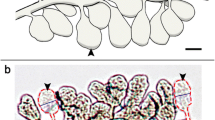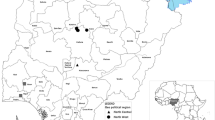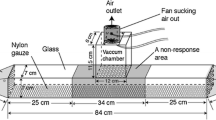Abstract
The 10 fatty acid ester components of brood pheromone were extracted from larvae of different populations of USA and South African honey bees and subjected to gas chromatography-mass spectrometry quantitative analysis. Extractable amounts of brood pheromone were not significantly different by larval population; however, differences in the proportions of components enabled us to classify larval population of 77% of samples correctly by discriminant analysis. Honeybee releaser and primer pheromone responses to USA,Africanized and–European pheromone blends were tested. Texas-Africanized and Georgia-European colonies responded with a significantly greater ratio of returning pollen foragers when treated with a blend from the same population than from a different population. There was a significant interaction of pheromone blend by adult population source among Georgia-European bees for modulation of sucrose response threshold, a primer response. Brood pheromone blend variation interacted with population for pollen foraging response of colonies, suggesting a self recognition cue for this pheromone releaser behavior. An interaction of pheromone blend and population for priming sucrose response thresholds among workers within the first week of adult life suggested a more complex interplay of genotype, ontogeny, and pheromone blend.




Similar content being viewed by others
Abbreviations
- BP:
-
brood pheromone
References
DANKA, R. G., HELLMICH, R. L., RINDERER, T. E., COLLINS, A. M. 1987. Diet-selection ecology of tropically and temperately adapted honey bees. Anim. Behav. 35:1858–1863.
FEWELL, J. H., and BERTRAM, S. M. 2002. Evidence for genetic variation in worker task performance by African and European honey bees. Behav. Ecol. Sociobiol. 52:318–325.
HUBERTY, C. J. 1994. Applied Discriminant Analysis. Wiley, New York.
KEELING, C. I., SLESSOR, K. N., HIGO, H. A., and WINSTON, M. L. 2003. New components of the honey bee (Apis mellifera L.) queen retinue pheromone. Proc. Nat. Acad. Sci.USA. 100:4486–4491.
KOTZ, J. C., TREICHEL, P. M., WEAVER, G. C. 2006. Chemistry and General Reactivity. Brooks, Belmont.
LE CONTE, Y., SRENG, L., and TROUILLER, J. 1994. The recognition of larvae by worker honey bees. Naturwissenschaften 81:462–465.
LE CONTE, Y., MOHAMMEDI, A., and ROBINSON, G. E. 2001. Primer effects of a brood pheromone on honeybee behavioural development. Proc. R. Soc. London, B 268:163–168.
MICHELETTE, E. R., and SOARES, A. E. E. 1993. Characterization of the preimaginal development stages in Africanized honey bee workers (Apis mellifera L). Apidologie 24: 431–440.
MOHAMMEDI, A., CRAUSER, D., PARIS, A., and LE CONTE, Y. 1996. Effect of a brood pheromone on honeybee hypopharyngeal glands. C. R. Acad. Sci. Paris, Sciences de la vie. 319:769–772.
OVERALL, J. E., and KLETT, C. J. 1972. Applied Multivariate Analysis. McGraw-Hill, New York.
PAGE, R. E., and ERBER, J. 2002. Levels of behavioral organization and the evolution of division of labor. Naturwissenschaften 89:91–106
PANKIW, T. 2003. Directional change in a suite of foraging behaviors in tropical and temperate evolved honey bees (Apis mellifera L.). Behav. Ecol. Sociobiol. 54:458–464.
PANKIW, T. 2004a. Brood pheromone regulates foraging activity of honey bees (Hymenoptera: Apidae). J. Econ. Entomol. 97:748–751.
PANKIW, T. 2004b. Cued in: honey bee pheromones as information flow and collective decision-making. Apidologie 35:217–226.
PANKIW, T. 2007. Brood pheromone modulation of pollen forager turnaround time in the honey bee (Apis mellifera L.). J. Insect. Behav. 20:173–180.
PANKIW, T., and PAGE, R. E. 2001. Brood pheromone modulates sucrose response thresholds in honeybees (Apis mellifera). Behav. Ecol. Sociobiol. 49:206–213.
PANKIW, T., and RUBINK, W. L. 2002. Pollen foraging response to brood pheromone by Africanized and European honey bees (Apis mellifera L.). Ann. Entomol. Soc. Am. 95:761–767.
PANKIW, T., PAGE, R. E., and FONDRK, M. K. 1998. Brood pheromone stimulates pollen foraging in honey bees (Apis mellifera). Behav. Ecol. Sociobiol. 44:193–198.
PANKIW, T., TARPY, D. R., and PAGE, R. E. 2002. Genotype and rearing environment affect honeybee perception and foraging behaviour. Anim. Behav. 64:663–672.
PANKIW, T., ROMAN, R., SAGILI, R. R., and ZHU-SALZMAN, K. 2004. Pheromone-modulated behavioral suites influence colony growth in the honey bee (Apis mellifera). Naturwissenschaften 91:575–578.
PANKIW, T., LAFONTAINE, J. P., and AVELINO, N. 2008a. Stabilized synthetic brood pheromone for manipulating the behaviour and physiology of honey bees. International Patent WO/2008/028269. Published March 13, 2008.
PANKIW, T., SAGILI, R. R., and METZ, B. N. 2008b. Brood pheromone effects on colony protein supplement consumption and growth in the honey bee (Hymenoptera: Apidae) in a subtropical climate. J. Econ. Entomol. 101:1749–1755.
PESANTE, D., RINDERER, T. E., and COLLINS, A. M. 1987. Differential pollen collection by Africanized and European honeybees in the neotropics. J. Apic. Res. 26:24–29.
PINTO, M. A., JOHNSTON, J. S., RUBINK, W. L., COULSON, R. N., and PATTON, J. C., SHEPPARD, W. S. 2003. Identification of Africanized honey bee (Hymenoptera: Apidae) mitochondrial DNA: validation of a rapid polymerase chain reaction-based assay. Ann. Entomol. Soc. Am. 96:679–684.
PINTO, M. A., PATTON, J. C., COULSON, R. N., and JOHNSTON, J. S. 2005. Africanization in the United States: replacement of feral European honeybees (Apis mellifera L.). Genetics 170:1653–1665.
REMBOLD, H., KREMER, J. P., and ULRICH, G. M. 1980. Characterization of postembryonic developmental stages of the female castes of the honey bee, Apis mellifera L. Apidologie 11: 29–38.
RUTTNER, F. 1988. Biogeography and Taxonomy of Honeybees. Springer-Verlag, Berlin.
SAGILI, R. R. 2007. Evaluation of physiological and pheromonal factors regulating honey bee, Apis mellifera L. (Hymenoptera: Apidae) foraging and colony growth. Dissertation, Texas A&M University.
SCHIFF, N. M., and SHEPPARD, W. S. 1995. Genetic analysis of commercial honey bees (Hymenoptera: Apidae) from the southern United States. J. Econ. Entomol. 88:1216–1220.
SCHIFF, N. M., SHEPPARD, W. S., LOPER, G. M., and SHIMANUKI, H. 1994. Genetic diversity of feral honey bee (Hymenoptera: Apidae) populations in the southern United States. Ann. Entomol. Soc. Am. 81:886–889.
SHEPPARD, W. S. 1989. A history of the introduction of honey bee races into the United States. Am. Bee J. 129:617–619 and 664–667.
SOKAL, R. R., and ROHLF, F. J. 1995. Biometry: The Principles and Practice of Statistics in Biological Research. Freeman, New York.
SPSS (2007) SPSS: Advanced Statistics 16.01 for Windows. SPSS, Inc., Cary, NC.
TARPY, D. R., NIELSEN, R., and NIELSEN, D. I. 2004. A scientific note on the revised estimates of effective paternity frequency in Apis. Insectes Soc. 51:203–204.
USDA-ARS. 2008. Spread of Africanized honey bees by year, by county. United States Department of Agriculture. http://www.ars.usda.gov/Research/docs.htm?docid=11059. Accessed 20 Feb 2009.
WINSTON, M. L. 1987. The Biology of the Honey Bee. Harvard University, Cambridge.
WINSTON, M. L. 1992. The biology and management of Africanized honey bees. Annu. Rev. Entomol. 37:173–193.
Acknowledgements
For editorial notes and field assistance, the authors are indebted to Vincent Dietemann. The authors also thank Christian Pirk, GW Burlin, Art Cavazos, Lizette Peters, Ramesh Sagili, and Howard Williams for technical support and assistance. This study was funded by grants from the USDA-NRI 2004-35302-15031 and the Texas Honey Bee Legislative Initiative.
Author information
Authors and Affiliations
Corresponding author
Rights and permissions
About this article
Cite this article
Metz, B.N., Pankiw, T., Tichy, S.E. et al. Variation in and Responses to Brood Pheromone of the Honey Bee (APIS mellifera L.). J Chem Ecol 36, 432–440 (2010). https://doi.org/10.1007/s10886-010-9775-5
Received:
Revised:
Accepted:
Published:
Issue Date:
DOI: https://doi.org/10.1007/s10886-010-9775-5




